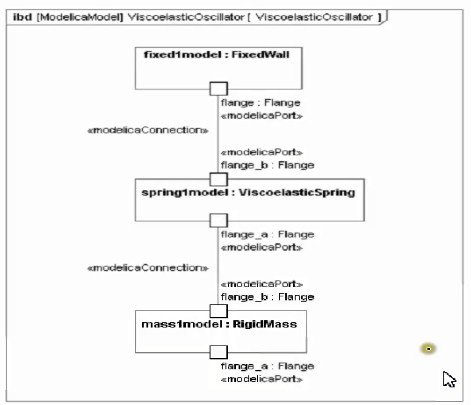Exam Details
Exam Code
:OMG-OCSMP-MBA400Exam Name
:OMG-Certified Systems Modeling Professional - Model Builder - AdvancedCertification
:OMG CertificationsVendor
:OMGTotal Questions
:90 Q&AsLast Updated
:Mar 25, 2025
OMG OMG Certifications OMG-OCSMP-MBA400 Questions & Answers
-
Question 11:
Choose the correct answer
How does the Survey of MBSE Methodologies define a methodology
A. A methodology consists of techniques for performing a single task
B. A methodology is a collection of related processes, methods, and tools
C. A methodology is an instrument that can enhance the efficiency of a task
D. A methodology is a logical sequence of tasks to achieve particular objective
-
Question 12:
Choose the correct answer
A systems engineer is responsible for deploying a model-based systems engineering approach on an unprecedented system, with unclear or incomplete user and system requirements.
What is the most important factor the engineer should consider in selecting a system development methodology?
A. the ability to rapidly prototype the user interface
B. access to a large model library and legacy code base
C. a robust ontology for characterizing complex systems
D. the ability to rapidly explore required system functionality
E. direct support for quickly characterizing and prototyping services
-
Question 13:
Choose the correct answer
Which SysML diagram type is a modification of the UML Class diagram?
A. Parametric Diagram
B. Internal Block Diagram
C. Package Diagram
D. Block Definition Diagram
-
Question 14:
Choose the coned answer
What characterizes a complete SysML model?
A. All of its element trace back to requirements that are within the scope of the project
B. It uses all SysML diagram types to model all aspects of the system or part being modeled.
C. It includes a complete set of SysML constructs and associations for the system being modeled
D. It has all the necessary information relevant at the level of abstraction that the model represents.
-
Question 15:
Choose the correct answer
Which aspect of a MBSE-based engineering project falls outside of the scope of AP233?
A. diagrams
B. slate machines
C. lifecycle stages
D. issue management
-
Question 16:
Choose the correct answer.
Given the following diagram:

Assume that all stereotypes required by the SysML-Modehca Transformation specification (if any) have been applied but are not necessarily shown here Assume that FixedWall. ViscoelasticSpring. and RigidMass are fully defined in a Modelica library.
What else must be done to get this model ready for solving according to the SysML- Modelica Transformation specification?
A. Provide specific values. Also define a parametric diagram that includes equations for Kirchhoffs Laws consistent with the above ibd.
B. Provide specific values Nothing else is required, as Kirchhoff's I laws are automatically taken care of consistent with the above ibd
C. Nothing - it is ready as-is
D. Modelica cannot handle this type of nonlinear model
-
Question 17:
Choose the correct answer
What is best practice to model a software application in a SysML model for a system?
A. block stereotyped with 玸oftware?represents the software application and its interfaces
B. A class stereotyped with 玸oftware?represents the software application and its interfaces
C. A component stereotyped with 玸oftware?represents the software application and its interfaces.
D. Software is typically not modeled in a system SysML model
-
Question 18:
Choose the correct answer
How is the concept of coupling used to assess model quality?
A. High coupling leads to good model quality provided all blocks in a structural model exhibit the same average degree of coupling
B. High coupling leads to poof model quality because it decreases reuse potential and prevents independent modification of system elements
C. Low coupling leads to poor model quality because all parts of a system must be properly coupled in order to measure the completeness of the model
D. Coupling has no bearing on model quality because no metrics exist for measuring the level of coupling of SysML models
-
Question 19:
Choose the correct answer.
What is common practice when integrating software models into SysML system models?
A. The software is specified with UML in the SysML system model
B. The software is specified with SysML in the SysML system model.
C. Cross-relationships are defined between a UML software model and a SysML system model
D. A model-to-model transformation integrates a UML software model into a SysML system model
-
Question 20:
Choose the correct answer
Understanding OCL is important to the understanding of which item(s)?
A. a typical high-level domain model
B. tool-generated XMI for a SysML model
C. both the UML and SysML specifications
D. software developers' modifications to a SysML model
Related Exams:
OMG-OCSMP-MBA400
OMG-Certified Systems Modeling Professional - Model Builder - AdvancedOMG-OCSMP-MBI300
OMG-Certified Systems Modeling Professional - Model Builder - IntermediateOMG-OCUP-100
OMG-Certified UML Professional FundamentalOMG-OCUP-200
OMG-Certified UML Professional IntermediateOMG-OCUP-300
OMG-Certified UML Professional - AdvancedOMG-OCUP2-ADV300
OMG Certified UML Professional 2 (OCUP 2) - Advanced LevelOMG-OCUP2-FOUND100
OMG Certified UML Professional 2 (OCUP 2) - Foundation LevelOMG-OCUP2-INT200
OMG Certified UML Professional 2 (OCUP 2) - Intermediate LevelUM0-100
OMG-Certified Uml Professional - FundamentalUM0-200
OMG-Certified Uml Professional - Intermediate
Tips on How to Prepare for the Exams
Nowadays, the certification exams become more and more important and required by more and more enterprises when applying for a job. But how to prepare for the exam effectively? How to prepare for the exam in a short time with less efforts? How to get a ideal result and how to find the most reliable resources? Here on Vcedump.com, you will find all the answers. Vcedump.com provide not only OMG exam questions, answers and explanations but also complete assistance on your exam preparation and certification application. If you are confused on your OMG-OCSMP-MBA400 exam preparations and OMG certification application, do not hesitate to visit our Vcedump.com to find your solutions here.